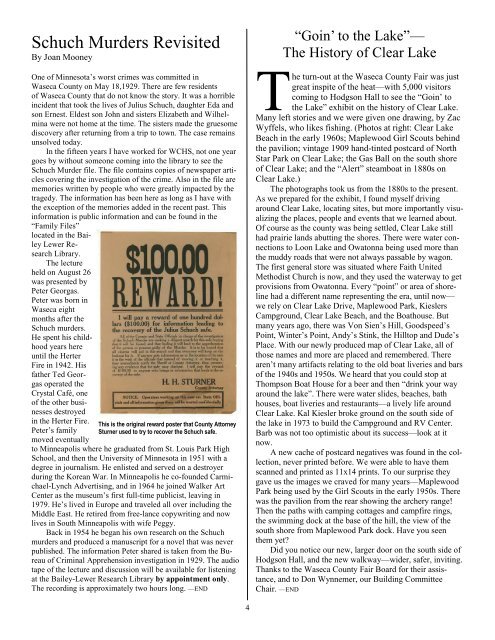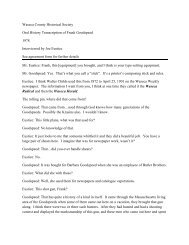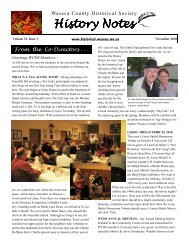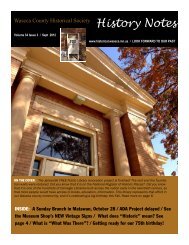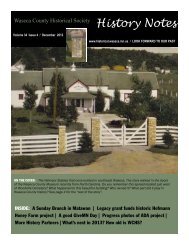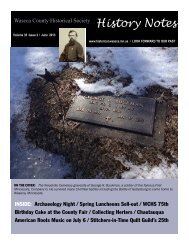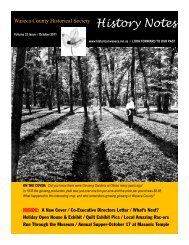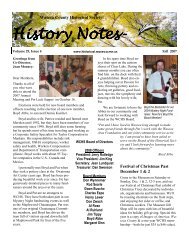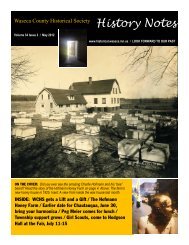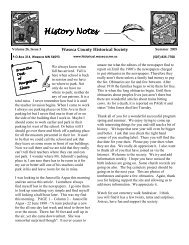August 2010 - Waseca County Historical Society
August 2010 - Waseca County Historical Society
August 2010 - Waseca County Historical Society
Create successful ePaper yourself
Turn your PDF publications into a flip-book with our unique Google optimized e-Paper software.
Schuch Murders Revisited<br />
By Joan Mooney<br />
One of Minnesota’s worst crimes was committed in<br />
<strong>Waseca</strong> <strong>County</strong> on May 18,1929. There are few residents<br />
of <strong>Waseca</strong> <strong>County</strong> that do not know the story. It was a horrible<br />
incident that took the lives of Julius Schuch, daughter Eda and<br />
son Ernest. Eldest son John and sisters Elizabeth and Wilhelmina<br />
were not home at the time. The sisters made the gruesome<br />
discovery after returning from a trip to town. The case remains<br />
unsolved today.<br />
In the fifteen years I have worked for WCHS, not one year<br />
goes by without someone coming into the library to see the<br />
Schuch Murder file. The file contains copies of newspaper articles<br />
covering the investigation of the crime. Also in the file are<br />
memories written by people who were greatly impacted by the<br />
tragedy. The information has been here as long as I have with<br />
the exception of the memories added in the recent past. This<br />
information is public information and can be found in the<br />
“Family Files”<br />
located in the Bailey<br />
Lewer Research<br />
Library.<br />
The lecture<br />
held on <strong>August</strong> 26<br />
was presented by<br />
Peter Georgas.<br />
Peter was born in<br />
<strong>Waseca</strong> eight<br />
months after the<br />
Schuch murders.<br />
He spent his childhood<br />
years here<br />
until the Herter<br />
Fire in 1942. His<br />
father Ted Georgas<br />
operated the<br />
Crystal Café, one<br />
of the other businesses<br />
destroyed<br />
in the Herter Fire.<br />
Peter’s family<br />
moved eventually<br />
This is the original reward poster that <strong>County</strong> Attorney<br />
Sturner used to try to recover the Schuch safe.<br />
to Minneapolis where he graduated from St. Louis Park High<br />
School, and then the University of Minnesota in 1951 with a<br />
degree in journalism. He enlisted and served on a destroyer<br />
during the Korean War. In Minneapolis he co-founded Carmichael-Lynch<br />
Advertising, and in 1964 he joined Walker Art<br />
Center as the museum’s first full-time publicist, leaving in<br />
1979. He’s lived in Europe and traveled all over including the<br />
Middle East. He retired from free-lance copywriting and now<br />
lives in South Minneapolis with wife Peggy.<br />
Back in 1954 he began his own research on the Schuch<br />
murders and produced a manuscript for a novel that was never<br />
published. The information Peter shared is taken from the Bureau<br />
of Criminal Apprehension investigation in 1929. The audio<br />
tape of the lecture and discussion will be available for listening<br />
at the Bailey-Lewer Research Library by appointment only.<br />
The recording is approximately two hours long. —END<br />
“Goin’ to the Lake”—<br />
The History of Clear Lake<br />
T<br />
he turn-out at the <strong>Waseca</strong> <strong>County</strong> Fair was just<br />
great inspite of the heat—with 5,000 visitors<br />
coming to Hodgson Hall to see the “Goin’ to<br />
the Lake” exhibit on the history of Clear Lake.<br />
Many left stories and we were given one drawing, by Zac<br />
Wyffels, who likes fishing. (Photos at right: Clear Lake<br />
Beach in the early 1960s; Maplewood Girl Scouts behind<br />
the pavilion; vintage 1909 hand-tinted postcard of North<br />
Star Park on Clear Lake; the Gas Ball on the south shore<br />
of Clear Lake; and the “Alert” steamboat in 1880s on<br />
Clear Lake.)<br />
The photographs took us from the 1880s to the present.<br />
As we prepared for the exhibit, I found myself driving<br />
around Clear Lake, locating sites, but more importantly visualizing<br />
the places, people and events that we learned about.<br />
Of course as the county was being settled, Clear Lake still<br />
had prairie lands abutting the shores. There were water connections<br />
to Loon Lake and Owatonna being used more than<br />
the muddy roads that were not always passable by wagon.<br />
The first general store was situated where Faith United<br />
Methodist Church is now, and they used the waterway to get<br />
provisions from Owatonna. Every “point” or area of shoreline<br />
had a different name representing the era, until now—<br />
we rely on Clear Lake Drive, Maplewood Park, Kieslers<br />
Campground, Clear Lake Beach, and the Boathouse. But<br />
many years ago, there was Von Sien’s Hill, Goodspeed’s<br />
Point, Winter’s Point, Andy’s Stink, the Hilltop and Dude’s<br />
Place. With our newly produced map of Clear Lake, all of<br />
those names and more are placed and remembered. There<br />
aren’t many artifacts relating to the old boat liveries and bars<br />
of the 1940s and 1950s. We heard that you could stop at<br />
Thompson Boat House for a beer and then “drink your way<br />
around the lake”. There were water slides, beaches, bath<br />
houses, boat liveries and restaurants—a lively life around<br />
Clear Lake. Kal Kiesler broke ground on the south side of<br />
the lake in 1973 to build the Campground and RV Center.<br />
Barb was not too optimistic about its success—look at it<br />
now.<br />
A new cache of postcard negatives was found in the collection,<br />
never printed before. We were able to have them<br />
scanned and printed as 11x14 prints. To our surprise they<br />
gave us the images we craved for many years—Maplewood<br />
Park being used by the Girl Scouts in the early 1950s. There<br />
was the pavilion from the rear showing the archery range!<br />
Then the paths with camping cottages and campfire rings,<br />
the swimming dock at the base of the hill, the view of the<br />
south shore from Maplewood Park dock. Have you seen<br />
them yet<br />
Did you notice our new, larger door on the south side of<br />
Hodgson Hall, and the new walkway—wider, safer, inviting.<br />
Thanks to the <strong>Waseca</strong> <strong>County</strong> Fair Board for their assistance,<br />
and to Don Wynnemer, our Building Committee<br />
Chair. —END<br />
4


